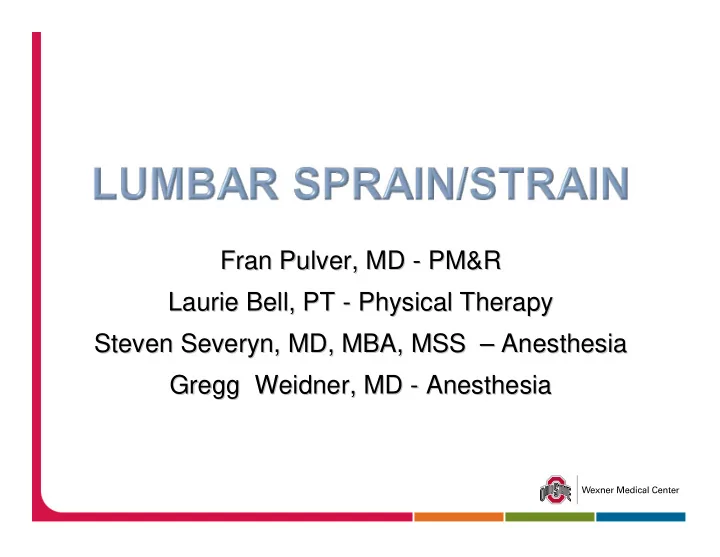

Fran Pulver, MD - - PM&R PM&R Fran Pulver, MD Laurie Bell, PT - - Physical Therapy Physical Therapy Laurie Bell, PT Steven Severyn, MD, MBA, MSS – – Anesthesia Anesthesia Steven Severyn, MD, MBA, MSS Gregg Weidner, MD - - Anesthesia Anesthesia Gregg Weidner, MD
Case Presentation-Lumbar Sprain/Strain Patient is 42 years old Had sudden low back pain with lifting boxes Pain is sharp and localized to the back. It is made worse with movement and not different with sitting or standing. There is only sharp stabbing, back pain, 5/10. No numbness or tingling or weakness Exam-normal except for tenderness in low back and some pain with movement
Lumbar sprain/strain Most common cause of acute low back pain Sprains and strains imply stretching or tearing of the tissue involved, either muscles (strain) or ligaments (sprain). Result from overuse or an acute injury Present with focal back pain with restricted motion. PULVER
Lumbar sprain/strain The pain of less severe lumbar sprains and strains typically lasts about 5 to 10 days. 90% of lumbar sprain/strains resolve regardless of kind of treatment in 6-12 weeks. If symptoms do not improve within this period of time, consider other diagnosis ICD-9 847.2 lumbar sprain, 846 lumbosacral sprain PULVER
Low Back Pain: Physical Therapy Perspective – Laurie Bell, PT Patient education Exercise/Modalities Length of treatment BELL
Lumbar Sprain: patient education Provide assurance to patients and advise them to remain active Avoid bed rest as a means of pain control Activity modification as needed Teach safe body mechanics Continue working if possible BELL
Lumbar Sprain: therapeutic exercise/modalities Ice if acute x 1-3 days Then heat if preferred: superficial heat,deep heat, ultra sound Electric stimulation to lessen pain and/or decrease muscle spasm BELL
Lumbar Sprain: length of treatment Assess for directional preference Stretching to improve ROM and muscle flexibility Core strengthening to improve spinal stability Functional exercise to return patient to all normal activities Length of treatment: average 6-10 visits BELL
Medications for Treatment of Lumbosacral Strain Steven A. Severyn, MD, MBA, MSS
Low Back Pain: Acute, Sub-acute, Chronic Pain, muscle tension, or stiffness with or without leg pain Acute: < 6 weeks Sub-acute: 6 weeks to 3 months Chronic: > 3 months Chronic condition occurs in 5-10% of patients with low back pain but is associated with majority of health care expense and socioeconomic costs SEVERYN
Lumbar Strain Muscles Rotatores lumborum longus/brevis muscles (segmental) Interspinalis lumborum muscles (segmental) Intertransversarius muscles (segmental) Multifidus Erector spinae Quadratus lumbotum Fascia Thoracolumbar (anterior, middle, and posterior layers) Ligaments Zygoapophyseal (facet) joint capsules (segmental) Interspinous (segmental) Supraspinous Iliolumbar Sacroiliac (partially segmental) Sarotuberous Sacrococcygeal (lateral and posterior) SEVERYN
SEVERYN
SEVERYN
Medications Acetaminophen NSAID Muscle relaxant Methocarbamol (Robaxin) Cyclobenzaprine (Flexeril) Tizanidine (Zanaflex) Metaxalone (Skelaxin) Carisoprodol (Soma) Tramadol (Ultram) Tricyclic antidepressant Nortriptyline (Pamelor) Amitriptyline (Elavil) SEVERYN
Medications Neuromodulators Gabapentin (Neurontin) Pregabalin (Lyrica) Corticosteroid (5 day course of oral medication) Narcotic analgesics (7-10 day course) Hydrocodone/APAP (Vicodin, Lortab, Norco) Oxycodone/APAP (Percocet) Local anesthetic injection Local steroid injection SEVERYN
Multi-modal Treatment Physical therapy (active, passive) Behaviorial therapy Massage Spinal manipulation Traction Accupuncture Prevention (conditioning) SEVERYN
Sprains and Strains Medical Management NSAIDS Muscle relaxants Anti-Convulsants Analgesics Topical Agents TENS Modalities WEIDNER
Sprains and Strains Interventional Techniques Ethyl Chloride or VapoCoolant Sprays Lidoderm Patches Trigger Point injections Acupuncture/ Dry Needling Joint Injections WEIDNER
Discussion and Questions
Recommend
More recommend